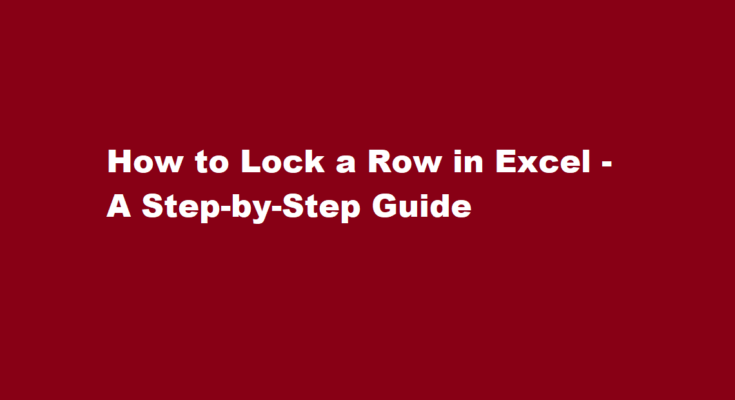Introduction
Microsoft Excel is a versatile spreadsheet application that offers a wide range of features to help users manage and analyze data effectively. One of these features is the ability to lock specific rows in a worksheet. Locking rows can be incredibly useful, especially when you want to keep certain information visible while scrolling through a large dataset. In this article, we will explore how to lock a row in Excel, step by step.
Why Lock a Row in Excel?
Locking a row in Excel can be advantageous for various reasons
- Data Reference Locking a row allows you to keep important headers or labels visible at all times, making it easier to reference information as you navigate through the spreadsheet.
- Data Entry When you have a long list of data to enter, locking headers can help ensure that you are entering data in the correct columns.
- Analysis Locking a row can be particularly helpful when you are working with a large dataset and need to compare or analyze data in different rows while keeping the column headers in view.
Now, let’s dive into the steps to lock a row in Excel.
Open Your Excel Workbook
Start by opening the Excel workbook in which you want to lock a row. Ensure that your worksheet contains the data and row you want to lock.
Select the Row to Be Locked
Click on the row number corresponding to the row you want to lock. This will select the entire row. You can do this by clicking on the row number on the left-hand side of the worksheet.
Access the Format Cells Dialog Box
Right-click on the selected row, and a context menu will appear. From this menu, choose “Format Cells.” Alternatively, you can press `Ctrl + 1` on your keyboard to open the Format Cells dialog box.
Navigate to the Protection Tab
In the Format Cells dialog box, go to the “Protection” tab. Here, you will find options related to locking cells.
Lock the Row
To lock the selected row, check the box that says “Locked.” This step tells Excel that you want to protect this row.
Apply Worksheet Protection
To actually enforce the locking of the row, you need to protect the entire worksheet. Go to the “Review” tab on the Excel ribbon and click on “Protect Sheet.” A “Protect Sheet” dialog box will appear.
Set a Password (Optional)
In the “Protect Sheet” dialog box, you have the option to set a password to prevent unauthorized users from unlocking the row or making changes to the worksheet. If you choose to set a password, make sure it’s something you can remember.
Choose Protection Options
Within the “Protect Sheet” dialog box, you can specify various protection options, such as allowing users to select locked cells, format cells, and more. Choose the options that suit your needs.
Confirm Protection
Click the “OK” button to confirm the worksheet protection settings. If you set a password, you will be prompted to confirm it. Make sure to remember the password, as it will be required to make any changes to the locked row or unprotected cells.
Save Your Workbook
Finally, save your workbook to apply the changes. Your selected row is now locked, and the worksheet is protected according to the options you specified.
FREQUENTLY ASKED QUESTIONS
How do you lock a row in Excel so it stays at the top?
From the View tab, Windows Group, click the Freeze Panes drop down arrow. Select either Freeze Top Row or Freeze First Column. Excel inserts a thin line to show you where the frozen pane begins.
How do I lock a cell in Excel formula?
Just select the cells you want to lock, then press F4. This will add the ‘$’ symbol to the cell references in the formula, locking the cells in place. For example, if you have a formula in cell A1 that references cell B1, and you press F4, the formula will change to =$A$1+$B$1.
Conclusion
Locking a row in Excel can help you maintain better control over your data and improve your efficiency when working with large datasets. By following the steps outlined in this article, you can easily lock a row and protect your worksheet from unintended changes. Whether you’re creating financial reports, tracking inventory, or managing project data, this feature can be a valuable addition to your Excel skills. So, next time you need to keep those headers or important data in view, remember how to lock a row in Excel.
Read Also : How to Lock a Row in Excel – A Step-by-Step Guide



